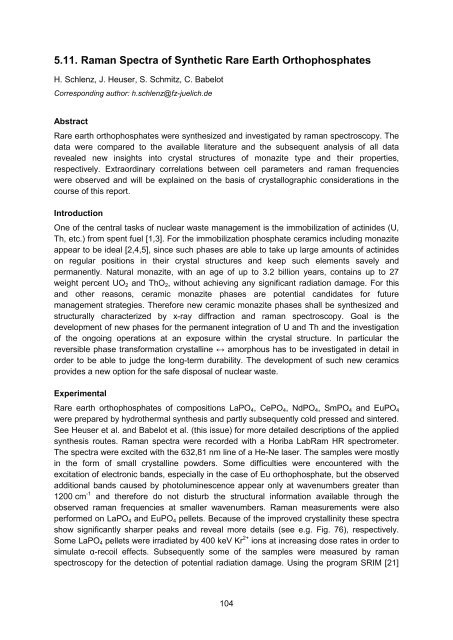Annual Report 2009/2010 - JUWEL - Forschungszentrum Jülich
Annual Report 2009/2010 - JUWEL - Forschungszentrum Jülich
Annual Report 2009/2010 - JUWEL - Forschungszentrum Jülich
Create successful ePaper yourself
Turn your PDF publications into a flip-book with our unique Google optimized e-Paper software.
5.11. Raman Spectra of Synthetic Rare Earth Orthophosphates<br />
H. Schlenz, J. Heuser, S. Schmitz, C. Babelot<br />
Corresponding author: h.schlenz@fz-juelich.de<br />
Abstract<br />
Rare earth orthophosphates were synthesized and investigated by raman spectroscopy. The<br />
data were compared to the available literature and the subsequent analysis of all data<br />
revealed new insights into crystal structures of monazite type and their properties,<br />
respectively. Extraordinary correlations between cell parameters and raman frequencies<br />
were observed and will be explained on the basis of crystallographic considerations in the<br />
course of this report.<br />
Introduction<br />
One of the central tasks of nuclear waste management is the immobilization of actinides (U,<br />
Th, etc.) from spent fuel [1,3]. For the immobilization phosphate ceramics including monazite<br />
appear to be ideal [2,4,5], since such phases are able to take up large amounts of actinides<br />
on regular positions in their crystal structures and keep such elements savely and<br />
permanently. Natural monazite, with an age of up to 3.2 billion years, contains up to 27<br />
weight percent UO 2 and ThO 2 , without achieving any significant radiation damage. For this<br />
and other reasons, ceramic monazite phases are potential candidates for future<br />
management strategies. Therefore new ceramic monazite phases shall be synthesized and<br />
structurally characterized by x-ray diffraction and raman spectroscopy. Goal is the<br />
development of new phases for the permanent integration of U and Th and the investigation<br />
of the ongoing operations at an exposure within the crystal structure. In particular the<br />
<br />
order to be able to judge the long-term durability. The development of such new ceramics<br />
provides a new option for the safe disposal of nuclear waste.<br />
Experimental<br />
Rare earth orthophosphates of compositions LaPO 4 , CePO 4 , NdPO 4 , SmPO 4 and EuPO 4<br />
were prepared by hydrothermal synthesis and partly subsequently cold pressed and sintered.<br />
See Heuser et al. and Babelot et al. (this issue) for more detailed descriptions of the applied<br />
synthesis routes. Raman spectra were recorded with a Horiba LabRam HR spectrometer.<br />
The spectra were excited with the 632,81 nm line of a He-Ne laser. The samples were mostly<br />
in the form of small crystalline powders. Some difficulties were encountered with the<br />
excitation of electronic bands, especially in the case of Eu orthophosphate, but the observed<br />
additional bands caused by photoluminescence appear only at wavenumbers greater than<br />
1200 cm -1 and therefore do not disturb the structural information available through the<br />
observed raman frequencies at smaller wavenumbers. Raman measurements were also<br />
performed on LaPO 4 and EuPO 4 pellets. Because of the improved crystallinity these spectra<br />
show significantly sharper peaks and reveal more details (see e.g. Fig. 76), respectively.<br />
Some LaPO 4 pellets were irradiated by 400 keV Kr 2+ ions at increasing dose rates in order to<br />
-recoil effects. Subsequently some of the samples were measured by raman<br />
spectroscopy for the detection of potential radiation damage. Using the program SRIM [21]<br />
104
















